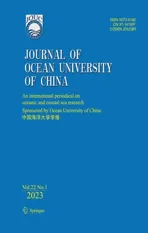L-Band Analysis of the Effects of Oil Slicks on Sea Wave Characteristics
2023-03-17JIANGTaoSHAOWeizengHUYuyiZHENGGangandSHENWei
JIANG Tao, SHAO Weizeng, , 3), *, HU Yuyi, ZHENG Gang, and SHEN Wei
L-Band Analysis of the Effects of Oil Slicks on Sea Wave Characteristics
JIANG Tao1), SHAO Weizeng1), 2), 3), *, HU Yuyi1), ZHENG Gang2), and SHEN Wei4), *
1) College of Marine Sciences, Shanghai Ocean University, Shanghai201306, China 2) State Key Laboratory of Satellite Ocean Environment Dynamics, Ministry of Natural Resources, Hangzhou 310012, China 3) National Satellite Ocean Application Service, Ministry of Natural Resources, Beijing100081, China 4) China Waterborne Transport Research Institute, Ministry of Transport, Beijing100088, China
The purpose of this study was to investigate the characteristics of sea surface waves as they pass through oil slicks. The parameterized first-guess spectrum method (PFSM) theory-based wave retrieval algorithm was applied to 20 images of horizon- tal-horizontal (HH) polarization obtained using the phased-array L-band synthetic aperture radar (SAR) (PALSAR) on the Advanced Land Observing Satellite (ALOS-1). The images were collocated with simulations from the WAVEWATCH-III (WW3) model in a 0.1˚ grid using the European Centre for Medium-Range Weather Forecasts (ECMWF) reanalysis (ERA-5) winds data as the forcing field. The validation of the model-simulated significant wave height (SWH) against the measurements from the Jason-2 altimeter produced a 0.66m root mean square error (RMSE) for the SWH, with a coefficient (COR) 0.74. In this sense, the WW3-simulated waves were reliable for our work. A comparison between the SAR retrieval results and the WW3 simulations was performed using the dataset for the regions without oil slicks, which produced a 0.34m RMSE for the SWH, with a COR of 0.79, which is less than a the RMSE of 0.52m and the COR of 0.70 for the regions with oil slicks. Moreover, it was found that the SAR-derived SWHs were significantly underestimated by about 0.2m in the areas with oil slicks. This difference is probably due to the underestimation of the SAR-derived wind speeds at moderate wind speeds (, at wind speeds of greater than 5ms−1). An additional analysis compared the SAR-derived wave spectra with those from the WW3 model as waves passed through the oil slicks. The interesting finding is that the wave energy at short wave lengths (about 30m) is reduced by the oil slicks, causing the movement of the dominant wave spectrum to shift to longer wave lengths (about 80m).
wind; wave; WAVEWATCH-III; ALOS-1 PALSAR; oil slicks
1 Introduction
Waves play an important role in atmospheric-marine in- teractions.Theyaffecteconomicactivitiesinnear-shorewa- ters, especially during tropical cyclones (Hu, 2020a). Strong waves are a danger to tankers and oil platforms and can result in accidental spills (Yang, 2021). With the development of remote-sensing techniques, spilled oil can be easily detected by optical and microwave satellites (Es- aias, 1998). However, oil slicks have a great influ- ence not only on the marine ecological environment but also on sea surface dynamics. An accurate understanding of sea surface dynamics is essential for predicting the move- mentofoilspillsusingnumericalmodels(Yang,2021). Until recently, few studies had been conducted concern-ing the characteristics of waves in the presence of oil slicks, finding that the damping of the gravity-capillary waves by oil slicks depends on the thickness of the oil slick (Er-makov, 2012).
Synthetic Aperture Radar (SAR) has the ability to meas- ure sea surface parameters (basically wind and waves) over a large area with a high spatial resolution,, a 100km swath with up to 1m pixel resolution for Chinese civilian SAR, denoted as Gaofen-3 (Shao, 2018c). The Geo- physical Model Function (GMF) CMOD (C-band, 5cm wavelength) and XMOD (X-band, 3cm wavelength) fam- ilies,, CMOD4 (Stoffelen and Anderson, 1997),CM- OD-IFR2 (Quilfen, 1998), CMOD5/CMOD5.N (Her-sbach, 2007; Hersbach, 2010), C-SARMOD (Mouche, 2005; Shao, 2021), and XMOD2 (Li and Leh- ner, 2014), are popular for wind retrieval from C-band SAR for the co-polarization channel. The phased-array L-band (24cm wavelength) synthetic aperture radar onboard the Advanced Land Observing Satellite (ALOS-1), for which the GMF for the L-band (Meng, 2022) is called LMOD, is specifically designed for wind retrieval (Isoguchi and Shimada, 2009). Because it is difficult to obtain a wind vector that includes both the wind speed and direction by solving the individual GMF, prior infor- mation about the wind direction from a reanalysis system (, the European Centre for Medium-Range Weather Forecasts (ECMWF)) (Shao, 2014a) is often used. The evaluation of the wind retrieval using co-polarized (vertical-vertical (VV) or horizontal-horizontal (HH)) SAR images has been well studied, and it has been concluded that the accuracy for C-band SAR is about 2ms−1,, ERS-1 (Lehner, 1998), Sentinel-1 (Monaldo, 2016), and RADARSAR-1/2 (Yang, 2011). This re- sult was also found for L-band SAR, such as the Japanese Earth Resources Satellite-1 (JERS) (Shimada, 2003) by applying the GMF LMOD. It should be noted that the LMOD was initially developed for HH-polarized SAR, and therefore, the polarization ratio (PR) model (Li, 2018) is not necessary when applying the VV-polarized GMF for the C- and X-band SAR.
SAR backscattering is distorted by the azimuthal (de- fined as the satellite flight direction) Doppler shift caused by the relative movement between the satellite platform and the sea surface (Honkavaara, 2013). This non-linear effect, which is known as the velocity bunching me- chanism (Alpers, 1981; Lyzenga, 2002), is stronger than the tilt modulation (Lyzenga, 1986) and hydrody- namic modulation (Feindt, 1986). Under these cir- cumstances, short waves with a wavelength smaller than the critical cutoff value are undetectable using SAR. Typi- ically, wave spectrum retrieval algorithms for co-polari- zed SAR consist of two types: SAR imaging mechanism-based algorithms and empirical approaches (Shao, 2015). The theory-based co-polarization algorithms in- clude the Max-Planck Institute (MPI) algorithm (Hassle- mann and Hasselmann, 1991), the semi-parametric retriev- al algorithm (SPRA) (Mastenbroke and Valk, 2000), the parameterized first-guess spectrum method (PFSM) (Sun and Kawamura, 2009), and the partition rescaling and shift algorithm (PARSA) (Shulz-Stellenfleth, 2005). One difficulty with these algorithms is the necessity of a first-guess wave spectrum in which the true wave spec- trum is inverted by minimizing the cost function in order to resolve the modulation transfer function (MTF) of the non-linear velocity bunching. In practice, the waves sim- ulated using a numerical wave model, such as the WAve model (WAM) (The Wamdi Group, 1988) in the MPI algo- rithm, and an empirical wind-sea model, such as the Joint North Sea Wave Project (JONSWAP) model (Hasselmann, 1973) in the SPRA algorithm, can be used as the first-guess wave spectrum. Although the SPRA algorithm is more commonly applied (Voorrips, 2001), it has been found that the error is inevitably included in the scheme of the SPRA algorithm due to the fact that the difference between the retrieved wind-sea mapping spectrum and the observed SAR spectrum is supposedly mapped to the swell, which usually contains the error of the wind-sea retrieval. To overcome this limitation, information about the wind-sea and swell in a SAR spectrum is first separated using the SAR-derived winds and satellite parameters. The best fit parameters for producing the first-guess wind-sea spec- trum,, the dominant wave phase velocity and wave propagation direction, are optimally selected in the em- pirical JONSWAP model. The PFSM algorithm has been successfully used for wave retrieval from Sentinel-1 (Ding, 2019)and Gaofen-3 (Zhu, 2019)SAR images. Using the backscattering signal in quad-polarization (ba- sically VV, HH, vertical-horizontal (VH)), the wave re- trieval algorithm for quad-polarized SAR initially proposedby Shao(2014a) has been proven to validate the wave retrieval from a number of quad-polarized RADARSAT-2 images against moored buoys (Zhang, 2010). In a recent study (He, 2006), the quad-polarization wave retrieval algorithm was implemented for GF-3 SAR data acquired in wave mode, revealing that the inverted SWH tends to become saturated at SWHs of up to 1.4m due to the low SAR backscattering signals of the cross-polariza- tion channel (Migliaccio, 2019).
The empirical approach is another option for SAR wave retrieval. Several studies have focused on exploring mod- els that allow the direct retrieval of the SWH without cal- culating complex MTFs for each modulation,, CWAVE for the C-band (Schulz-Stellenfleth, 2007; Li, 2011)and XWAVE for the X-band (Pleskachevsky, 2016). The principle behind the CWAVE and XWAVE families is that the SAR imaging parameters are deter- mined by the sea state. That is, the mapping mechanism for SAR can be bypassed to some extent by building an empirical function. One drawback of the empirical ap- proach is the intricate variables involved in the formulas selected by different researchers,, a set of orthonor- mal functions in a two-dimensional SAR spectrum and the azimuthal cutoff length because the cutoff length is propor- tional to the second moment of the wave spectrum (Grieco, 2016). Empirical models need to be adopted for spe- cific SAR sensors,, CWAVE_ERS (Schulz-Stellenfleth, 2007) for the ERS-1/2 SAR, CWAVE_ENV (Li, 2011) for the ENVISAT-ASAR, CWAVE_S1 for the Eu- ropean Sentinel-1 (S-1) SAR (Stopa and Mouche, 2017), and CSAR_WAVE for the Gaofen-3 (Sheng, 2018). Empirical models cannot be applied in the presence of oil slicks due to the effects induced by the spilled oil.
Oil slicks are detected more easily in C-band SAR im- ages than in L-band SAR images (Zheng, 2017) be- cause sea surface gravity waves are sensitive to micro- waves in the C-band. Therefore, the analysis on the effects of oil slicks on sea wave characteristics for L-band SAR could improve the accuracy of oil slick detection. In this study, 20 ALOS-1 PALSAR images in HH-polarization in which oil slicks created by ships could be seen were used to analyze the retrieval of wave characteristics using a PFSM algorithm. The purpose this study was to investi- gate the performance of the wave spectrum compared with those simulated using the WW3 model while passing oil slicks under various sea states. The remainder of this pa- per is organized as follows: the datasets are briefly de- scribed in Section 2,, ALOS-1 PALSAR images, measurements from the Advanced Scatterometer (ASCAT) and Jason-2 altimeter, and the settings of the WW3 model. Section 3 introduces the methodology of the existing the- ory-based PFSM algorithm. Section 4 presents the valida- tion of the wind and SWH data retrieved using the PFSM algorithm. This section also contains a discussion of the characteristics of the wave spectra as they pass through the oil slicks. The conclusions are summarized in Section 5.
2 Description of Datasets
A total of 20 ALOS-1 PALSAR images containing oil slicks were available for use in this study. The SAR prod- ucts were preceded to be Level-1.5 with the Fine Mode (FM) for the HH-polarization channel from March 2007 to May 2008. Fig.1 shows the geographic locations of the PALSAR images overlain with the water depth data from the General Bathymetric Chart of the Oceans (GEBCO) (Jakobsson and Macnab, 2006). The black rectangles rep- resent the spatial coverage of the collected images. The cali- bration method in Eq. (1) was used to collect the L-band HH-polarized normalized radar cross section (NRCS):

whereis the pixel intensity of the four-look 16-bit PALSAR images, andis a calibration factor, which is assumed to have a constant value of −83dB (Shimada, 2009). The radiometric accuracy of the PALSAR was de- termined to be 0.64dB, and the noise-equivalent NRCS, which was empirically estimated as the minimum area-av- eraged NRCS from the FM data, is approximately equal to−32dB. Fig.2 shows a calibrated quick-look of a PALSAR FM Geo-coded image acquired in the East China Sea at 14:20 UTC on July 22, 2007, in which rectangles A and B represent the geographic locations of the oil slicks. The spatial coverage of the SAR image ranges from 34.87˚N, 121.61˚E, to 35.46˚N, 122.41˚E, and the incidence angle ranges from 36.74˚ to 40.43˚. The dark patches marked in Fig.2 are caused by the ships monitored by the Automatic identification System (AIS).
To confirm the accuracy of the SAR-derived wind speeds,measurementswerecollectedfromtheASCAT25kmprod- ucts provided by the Royal Netherlands Meteorological Institute (Bi, 2011). The ASCAT scatterometer aboard the MetOp-A satellite operates in the C-band. Therefore, the winds were previously calculated based on the GMF CMOD5N, and the newly released products are based on the CMOD7 (Stoffelen, 2017). Because the local ob- servation time of the MetOp-A satellite is relatively close to that of ALOS-1, the matchups between the ASCAT and PALSAR have small time gaps (<15min) and are reliable for validation. The ASCAT data are the global wind speeds and directions on a 25km grid. A symmetric calibration was conductedcomparison of the ASCAT and more than 10000 ECMWF reanalysis (ERA-5) winds, yielding root-mean-square errors (RMSEs) of 1.26ms−1and about 15˚ for the wind speed and wind direction, respectively (Verspeek, 2010). Fig.3a shows the ASCAT-meas- ured wind map at 13:30 UTC on August 15, 2008. Be- cause the spatial resolution of the ASCAT is relatively coarse, which results in insufficient matchups with the SAR-derived winds,, no available ASCAT winds for the case in Fig.2, the ERA-5 winds for a 0.25˚ grid with an interval of 1h were also used to validate the SAR-derived winds, especially in the regions with oil slicks. A wind map from ERA-5 at 14:30 UTC on August 15, 2008, is shown in Fig.3b.
Wavessimulatedusingathird-generationnumericalmodel, denoted WAVEWATCH-III (version 6.07) (Tolman and Chalikov, 1996), were also collocated from the PAL- SAR images. The WW3 model has performed well in a global wave distribution analysis, even in areas with tropi- cal cyclones (Hu, 2020b) and in the Arctic Ocean (Shao, 2022). The forcing field was the 0.25˚ grid- ded ERA-5 reanalysis winds at an interval of 1h, and the water depths were derived from the GEBCO bathymetric data at 30 arc grids (about 1km spatial resolution in the horizontal direction). The computation settings were as follows: The frequency bins ranged logarithmically from 0.04118 to 0.7186 with an interval of 0.1; the spatial propagation was characterized by 300s time steps in both the longitudinal and latitudinal directions; the temporal re- solution was 30min; the spatial grid resolution was a 0.2˚ grid. The SWH product from the Jason-2 altimeter, which is a reliable remote-sensed source for sea height monitor- ing, was used to validate the WW3-simulation results. The switches described by the Wamdi Group (1988) illustrate the physical dynamics, which were as follows: The ST2 package was used for the input/dissipation source terms; the TR1 package was used for the triad wave-wave interac- tions; the GMD2 package was used for the quadruplet wave-wave interactions; the FLD2 package was used for the wave breaking. Fig.4 shows the WW3-simulated SWH map overlain with the footprints of the Jason-2 altimeter at 17:00 UTC on August 15, 2008. The statistical analysis of the SWH in August 2008 yielded a 0.66m RMSE with a 0.74 correlation coefficient (COR) between the WW3-simulated SWH and the measurements from the footprint of the Jason-2 altimeter (Fig.5) (Shao, 2018a, 2018b). Based on these results, we believe that waves simulated using the WW3 model are suitable for this study.
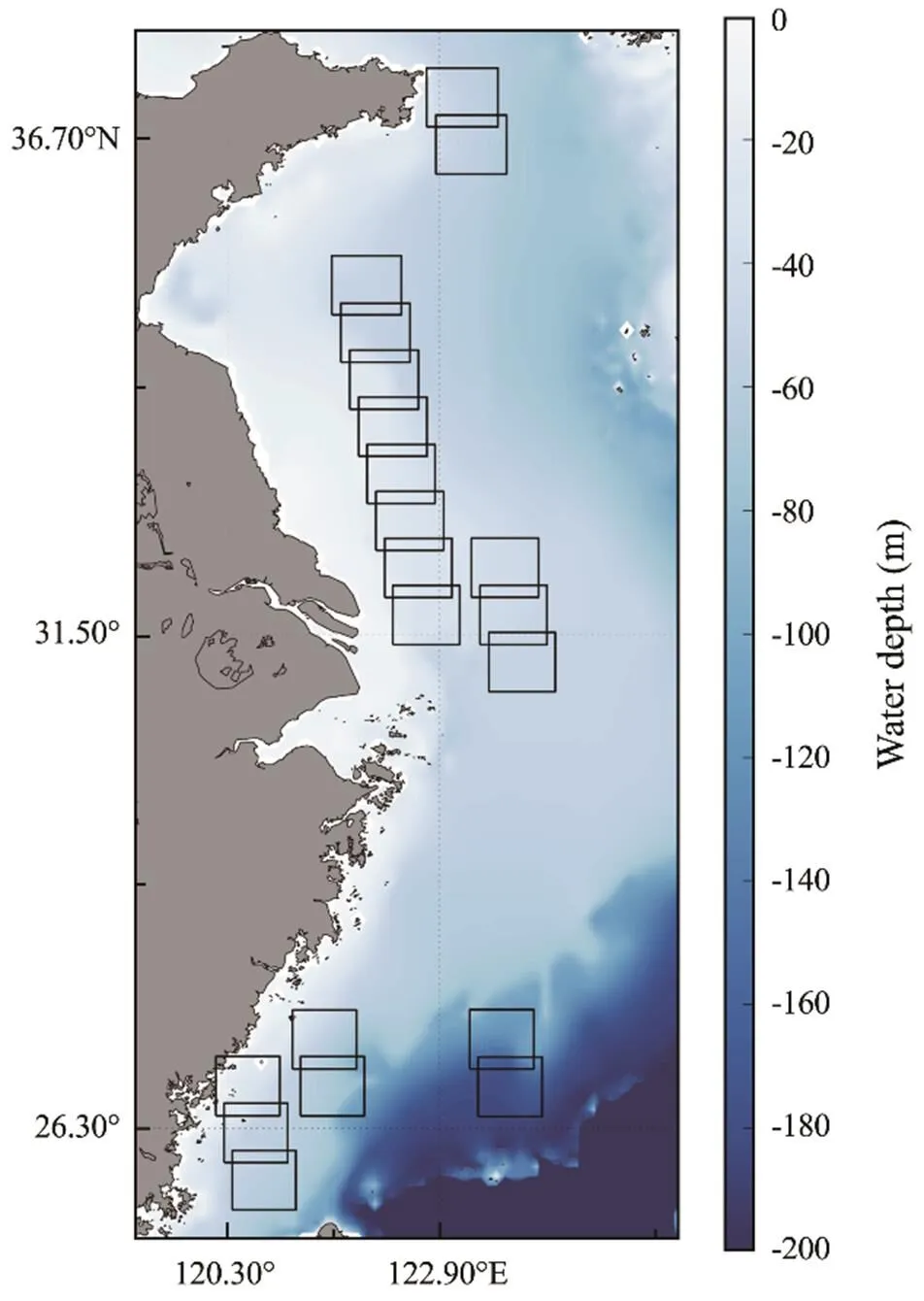
Fig.1 The geographic locations of the Advanced Land Ob- serving Satellite phased-array L-band synthetic aperture radar (SAR) (PALSAR) images overlain with the water depths, in which the black rectangles represent the spatial coverage of the collected images.

Fig.2 The calibrated quick-look of a horizontal-horizontal (HH) polarized PALSAR Geo-coded image acquired in the East China Sea at 14:20 UTC on July 22, 2007. Rectan- gles A and B represent the geographic locations of the oil slicks.
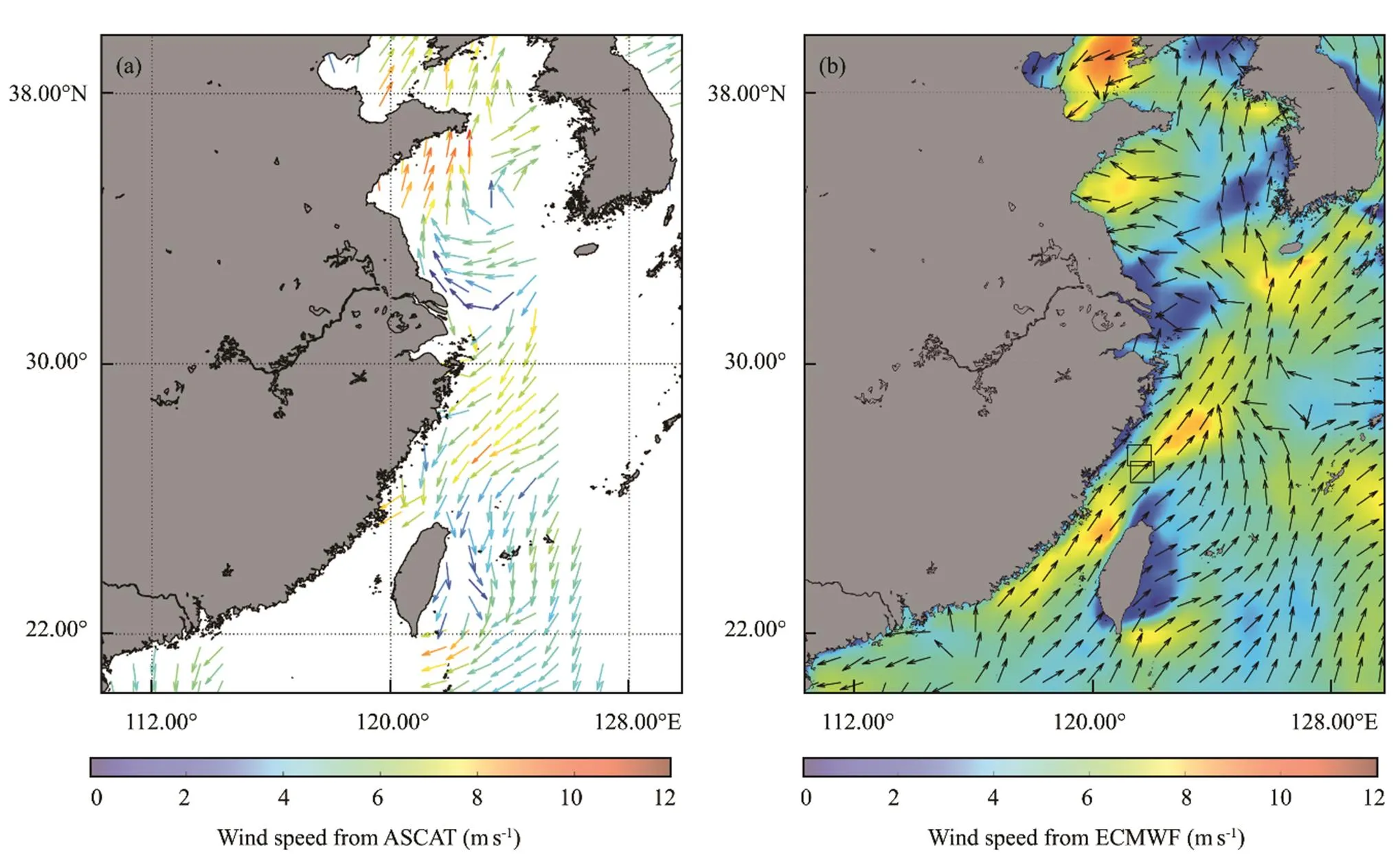
Fig.3 (a) The 0.25˚ grid wind map from the Advanced Scatterometer (ASCAT) at 13:30 UTC on August 15, 2008. (b) The 0.125˚ wind map from the European Centre for Medium-Range Weather Forecasts (ECMWF) reanalysis (ERA-5) at 14:30 UTC on August 15, 2008.
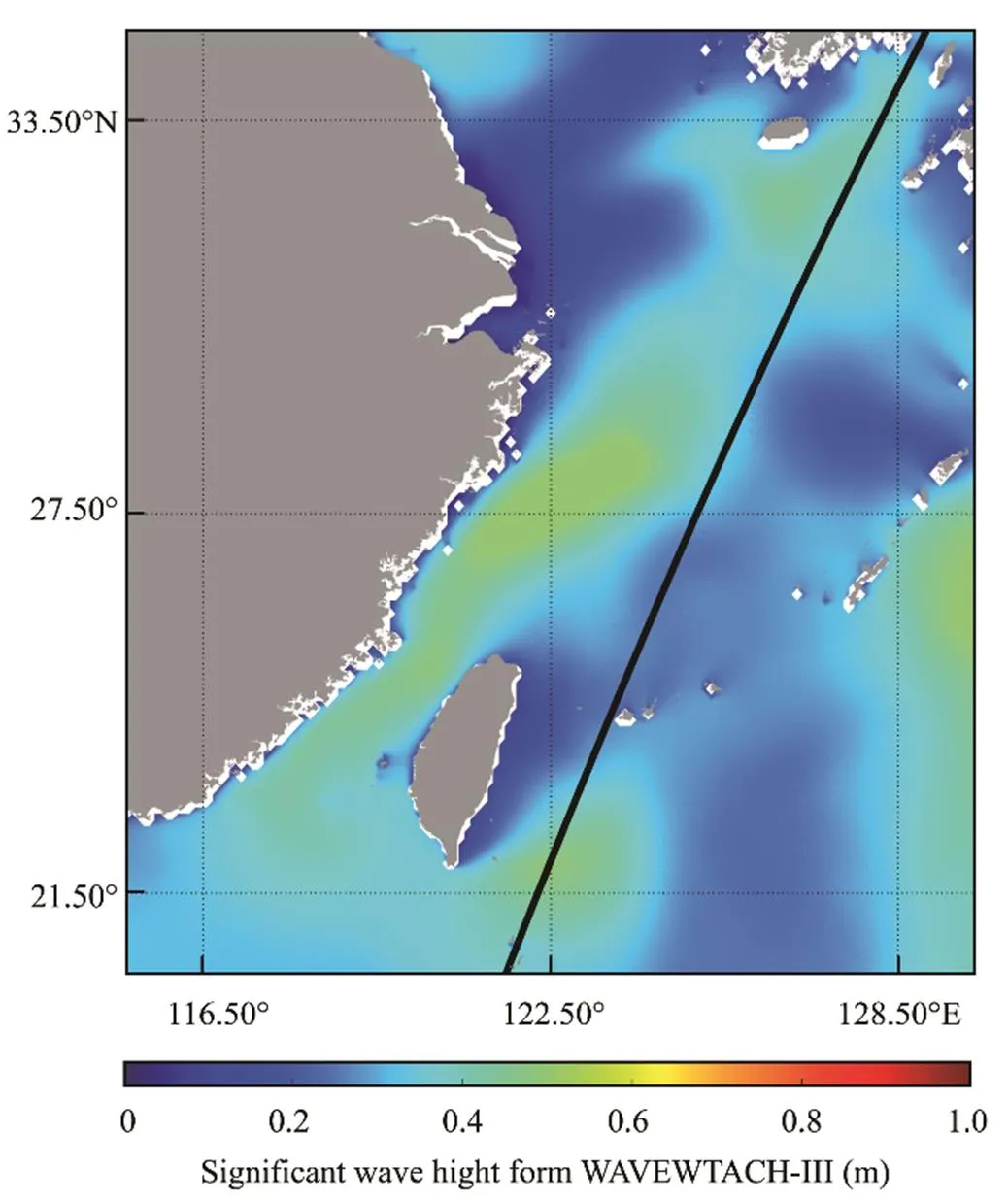
Fig.4 The simulated SWH map from the WAVEWATCH-III (WW3) model overlain on the footprints of the Jason-2 altimeter at 17:00 UTC on August 15, 2008.
3 Methodology
In this section, the wind retrieval GMF in the L-band, denoted as LMOD, is briefly described. Next, the scheme of the wave retrieval PFSM algorithm is discussed in de- tail. The comparison between the SWHs simulated using the WW3 model and the collocated measurements from the Jason-2 altimeter are also presented.
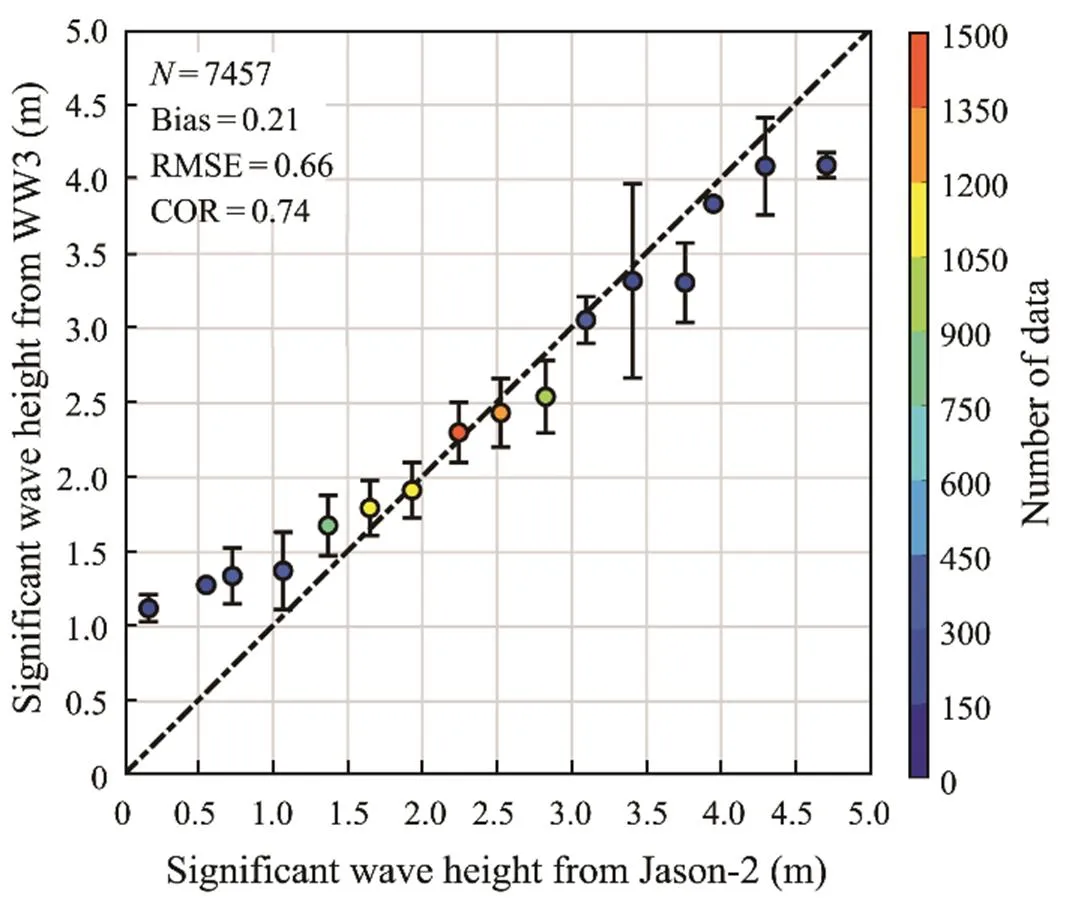
Fig.5 Comparison of the SWH from the WW3 model with the collocated matchups from the Jason-2 altimeter in Au- gust 2008.
3.1 GMF LMOD
Prior information about the wind speed is necessary for the PFSM algorithm. The wind retrieval GMF in the L-band, herein denoted as LMOD, has been described by Hersbach(2007). The LMOD function correlating a wind vector and NRCS has the following general formula:


In the entire image, there are-element referred wind directionsat locations (x,y). The weight radius, de- fined as the maximum distance at which the local wind is affected by the surroundings, is assumed to be 5km. For each sub-scene grid (x,y),0is the referred wind direc- tion andis the known wind direction nearest to the grid (x,y).Dis the spatial distance in km between grid (x,y) and grids (x,y), andD(=0−) is the difference be- tween wind direction0and the individual referred wind direction. Finally,,represents the SAR-derived wind direction at an about 1km grid and is interpolated using Eq. (3) (Shao, 2014b).

3.2 PFSM Algorithm
The first wave retrieval scheme for SAR was the scheme proposed by Sun and Kawamura (2009), denoted as MPI. It considers the non-linear mapping mechanism velocity bunching, which is a critical modulation of the SAR map- ping mechanism. The key of the MPI algorithm is to solve the MTF of the velocity bunching by minimizing the cost function(Eq. (4)), which relies on the first-guess wave spectrum simulated using a numeric model:

where

and







4 Results
In this section, the theory-based PFSM algorithm is ap- plied to 20 HH-polarization ALOS-1 PALSAR images, the retrieved wind speeds and SWHs are validated against the ASCAT-measured products and the simulations obtained using the WW3 model (Meng, 2022), and the re- gions with oil-like patterns in the images are selected for analysis.
4.1 Comparison of Wind Retrieval
Before the wind retrieval process, the NRCSs were av- eraged for a region of about 1km2centered at the wind observation points in order to remove the effect of the small-scale phenomena,, waves and swells. Using prior information about the wind direction, the wind speeds at a spatial resolution of about 1km were retrieved from the collected PALSAR images using the HH-polarized GMF LMOD. Fig.6 shows the SAR-derived wind map corre- sponding to the image in Fig.2. Wind speeds greater than 10ms−1are probably associated with the brightness in the image induced by ships. The accuracy of the wind re- trieval from the PALSAR images has an RMSE of about 2ms−1based on validation against moored buoys (Hu, 2020a). In this study, we simply repeated the comparison of the SAR-derived wind speeds with a few ASCAT winds during the periods in which the images were acquired (Fig.7). Generally, the analysis yielded a 1.82ms−1RMSE for the wind speed and a COR of 0.86. However, larger errors occurred at low wind speeds (10<2ms−1). This type of behavior has also been found for the implementa- tion of the CMOD family for RADARSAR-2 SAR (Shao, 2014b), and it is caused by weak backscattering at low wind speeds.
To study the influence of the oil slicks on the accuracy of the SAR-derived winds, ERA-5 winds at a 0.25˚ grid with an interval of 1h were collocated with the collected images. Fig.8a shows that the RMSE of the wind speed is 1.90ms−1and the COR is 0.84 for the regions without oil slicks, whereas the RMSE and COR are 2.70ms−1and 0.64, respectively, for the regions with oil slicks Fig.8b. The underestimation of the SAR-derived wind speeds clearly occurred when the wind speeds were greater than 5ms−1. However, the oil slicks likely have less influence on the wind retrieval at low wind speeds. In this sense, theSAR-derived winds are suitable for wave retrieval, al- though the accuracy of the winds is reduced by the modu- lation of the sea surface roughness induced by the oil slicks.
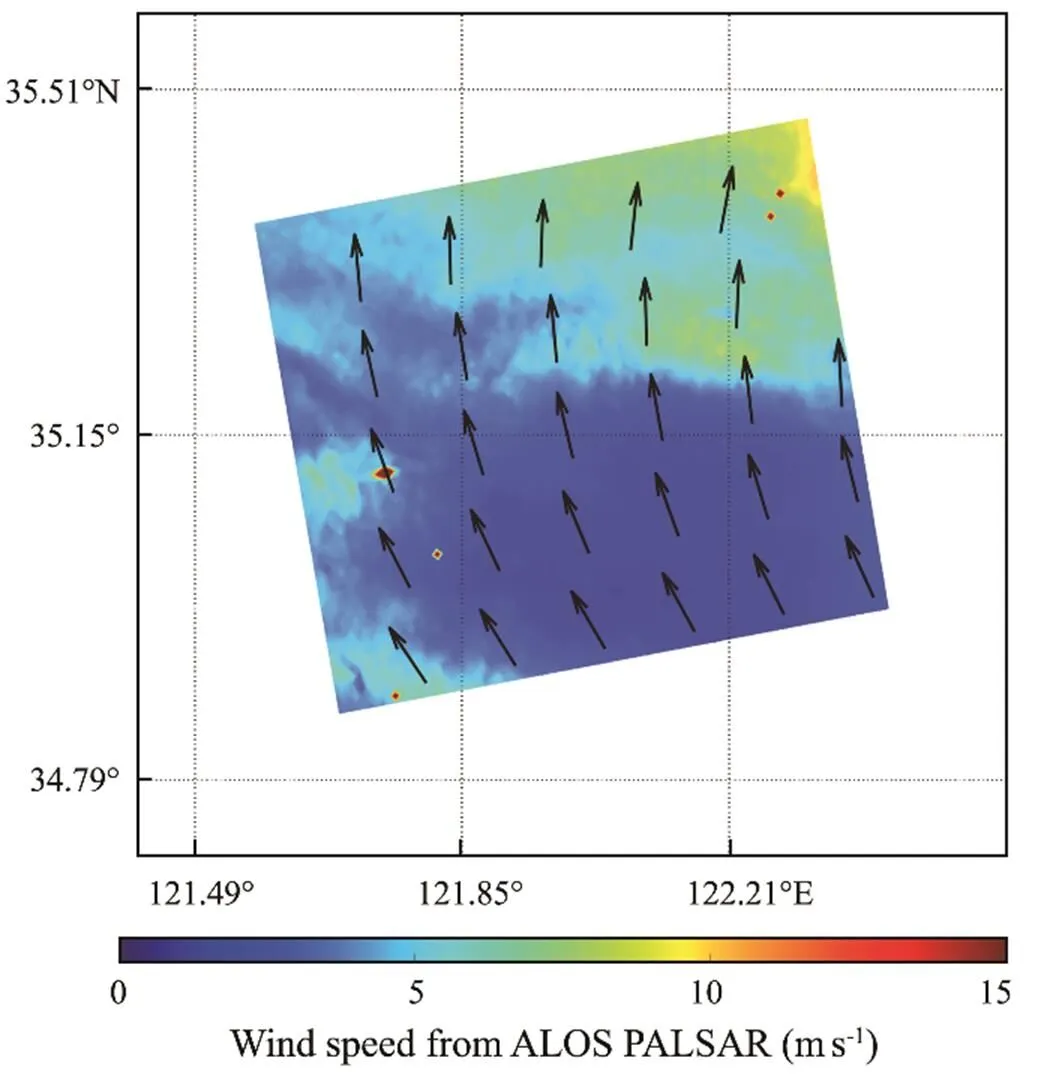
Fig.6 The wind map inverted from a HH-polarized PAL- SAR image using the geophysical model function LMOD, acquired in the East China Sea at 14:20 UTC on July 22, 2007.

Fig.7 Comparison of the SAR-derived wind speeds with a few ASCAT winds for a 1ms−1 bin between 0 and 11ms−1.

Fig.8 Comparisons between SAR-derived wind speeds from PALSAR images using LMOD with collocated ERA-5 wind speeds for a 0.5ms−1 bin. (a) in the regions without oil slicks, and (b) in the regions with oil slicks.
4.2 Comparison of SWH Retrieval
As is described by Velotto(2011), the oil slick’s contribution to the SAR backscattering is smaller in the VV-polarization channel than in the HH-polarization channel because the NRCS is more sensitive to the non-Bragg back- scattering caused by oil slicks (Kudryavtsev, 2003). Under these circumstances, the wave retrieval using theHH-polarized SAR is supposedly distorted by the oil slicks. Therefore, an analysis of the SWH retrieval from the HH-polarized PALSAR images is presented here to assess the influence of the oil slicks.
The retrieved results of a sub-scene extracted from the images taken on June 16, 2007, at 05:43 UTC using the existing PFSM algorithm are presented as an example of the retrieved results. In this case, the SWH simulated using the WW3 model was 0.75m. The geographic location is 120.48˚E, 25.81˚N, and the incidence angle is 37.15˚. Thequick-look image of the sub-scene covering the WW3 gridsat 0.1˚ grids is shown in Fig.9a, and the corresponding two-dimensional SAR spectrum is shown in Fig.9b. The SAR-derived SWH was obtained using the PFSM algorithmwas 0.39m, and the retrieved one-dimensional wave spec- trum (red dashed line) and the WW3-simulated wave spec- trum (blue dashed line) are shown in Fig.9c.
All of the sub-scenes extracted from the PALSAR im- ages were collocated with the simulations from the WW3 model in order to evaluate the accuracy of the SAR-de- rived SWH in the presence of oil slicks. Fig.10a shows that the SWH obtained using the PFSM algorithm has an RMSE of 0.34m and a COR of 0.79 for the regions without oil slicks. This is less than the RMSE and COR of 0.52m and 0.70, respectively, for the regions with oil slicks. In general, the SAR-derived SWH tends to be un- derestimated. This is caused by the underestimation of the SAR-derived wind speed (Fig.8). However, the larger dif- ference (about 0.2m) between the SAR-derived and WW3-simulated SWHs for the regions with oil slicks is clearly observed for SWHs of >0.7m because the oil slicks damp- en the sea surface roughness. The relationships between the incidence angle and the SAR-measured NRCS for the clean sea surface (red lines) and the oil-covered surface (black lines) were also analyzed. As can be seen from Fig.11a, the SAR-measured NRCS is significantly smaller than that in the clean region,, 2dB at an incidence angle of 40˚. For SWHs of >1m (Fig.11b), the values of the SAR-measured NRCS with oil slicks are close to those for the clean sea surface, indicating that oil slicks are difficult to detect under such conditions. This type of behavior is consistent with the findings of Meng(2022).
The PALSAR images taken on July 17, 2017, at 14:14 UTC were selected to analyze the results of the wave re- trieval as the waves passed through the oil slicks (Fig.12). Three profiles passed through the oil slicks induced by ships,, A-C, D-F, and G-I. The oil slicks were par- ticularly pronounced at locations B, E, and H. Fig.13 shows the retrieved results of the SAR-derived wave spec- tra obtained using the PFSM and the collocated wave spec- tra from the WW3 model, in which (a)-(i) correspond to A-I. Generally, the patterns of the SAR-derived wave spectra are consistent with the WW3-simulated wave spec- tra in the regions without oil slicks. It is not surpriseing that the normalized energy density from the SAR-derived wave spectrum is significantly reduced in the regions with oil slicks. In this case, the oil slicks likely dampen the short waves at wave numbers of 0.2radm−1(wavelengths of about 30m), causing a shift in the dominant wave energy towards longer wavelengths of 80m. This is illustrated at locations B (Fig.13b), E (Fig.13e), and H (Fig.13h). Col- lectively, the oil slicks dampen the wave energy at short wavelengths, and the oil slicks are more detectable under a weak sea state.
5 Summary and Conclusions
Accidental oil spills from ships are a major marine dis- aster in near-shore waters (Sergievskaya, 2019). Re- mote-sensing satellites are powerful tools for oil spill mon- itoring. Due to its fine resolution, SAR is particularly use- ful (Velotto, 2011). Most previous studies have fo- cused on detecting oil slicks using SAR images (Nunziata, 2018) and predicting the behavior of spilled oil using a numerical dynamics model (Price, 2006). Since oil slicks modulate the sea surface roughness, they could affect the wave retrieval for SAR. Therefore, the main purpose of this study was to investigate the results of the waves as they pass through oil slicks using 20 PALSAR images from ALOS-1. The HH-polarized GMF LMOD was used for the wind retrieval from the collected PALSAR images. Because the SAR-measured wind di- rections have a 180˚ ambiguity, 0.25˚ gridded ERA-5 winds were used to remove this ambiguity. The SAR-derived wind speeds were inverted from the PALAR images using the prior information about the wind directions in the GMF LMOD. The validation of the SAR-derived wind speeds for about 1000 matchups with ASCAT-measured winds produced a 1.82ms−1RMSE for the wind speed and a COR of 0.86. With respect to the effect of the oil slicks on the wind retrieval, comparisons with 0.25˚ gridded ERA-5 winds produced an RMSE and COR for the wind speed of 1.90ms−1and 0.84, respectively, for the regions without oil slicks, which are lower and higher than the RMSE and COR of 2.70ms−1and 0.64, respectively, for the regions with oil slicks. The underestimation (>1ms−1) of the SAR-derived wind speeds was particularly obvious when the wind speeds were greater than 5ms−1. This is- sue probably led to the underestimation of the SAR-de- rived SWH, indicating that the accuracy of the winds used in the wave retrieval process could affect the accuracy of the retrieved SWH. Moreover, a large difference in the SWH (about 0.2m) was achieved when comparing the SAR-derived and WW3-simulated SWHs for the regions with oil slicks. Three profiles passing through the oil slicks were analyzed in order to investigate the effects of the oil slicks on SAR-derived wave spectrum compared with those from the WW3 model. We found that short wave- lengths (<30m) were dampened by the oil slicks, and thus, the dominant wave spectra shifted toward longer wave- lengths (about 80m). We also found that oil spills are more detectable under weak sea states (SWH<1m). and thus, the dominant wave spectra shifted toward longer wave- lengths (about 80m). We also found that oil spills are more detectable under weak sea states (SWH<1m).

Fig.9 (a) The sub-scene extracted from the images taken on June 16, 2007, at 05:43 UTC; (b) the corresponding two-di- mensional SAR spectrum; and (c) the inverted one-dimensional wave spectrum obtained using the PFSM algorithm (red dashed line) and the WW3-simulated wave spectrum (blue dashed line).
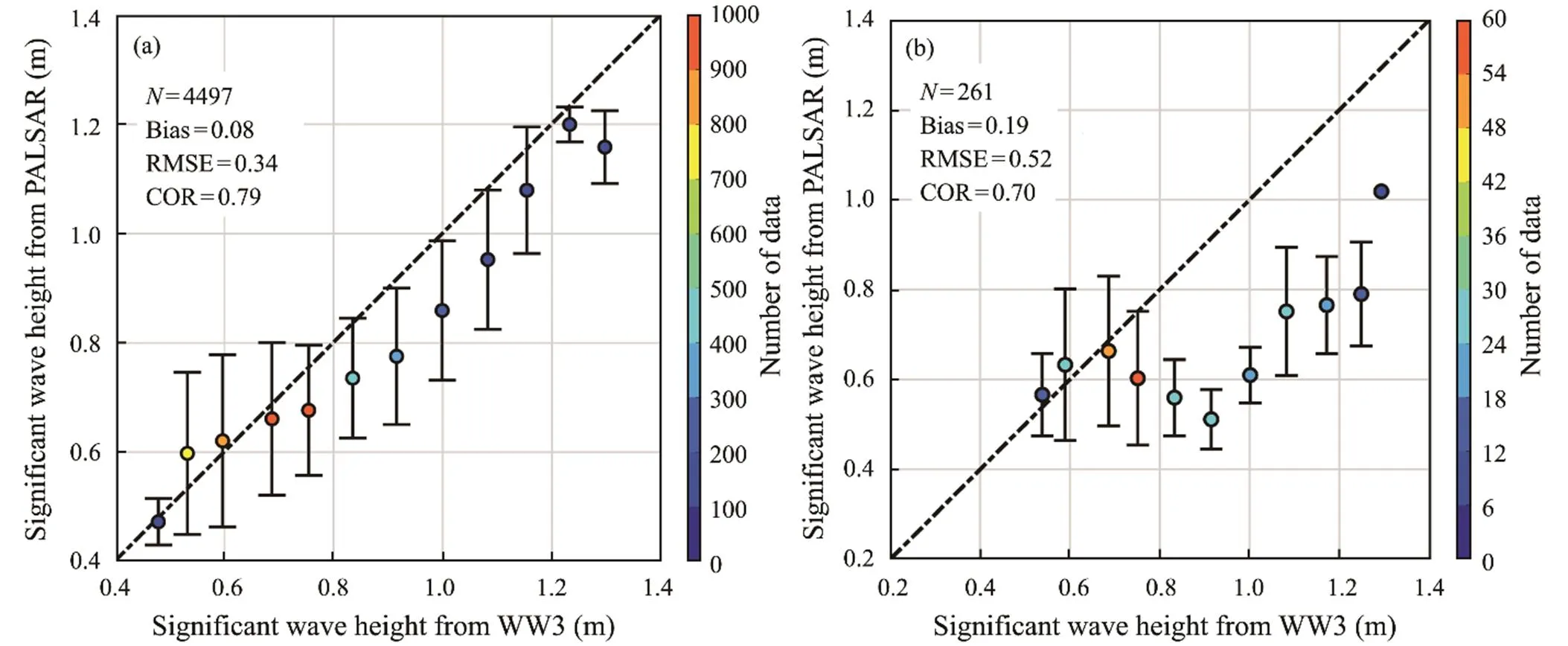
Fig.10 Comparisons between the SAR-derived SWH obtained from the PALSAR images using the PFSM algorithm and the collocated simulations from the WW3 model for a 0.1m bin (a) in the regions without oil slicks and (b) in the regions with oil slicks.

Fig.11 The relationships between the incidence angle and SAR-measured NRCS for the clean sea surface (red lines) and oil covered surface (black lines): (a) SWH<1m; (b) SWH>1m.

Fig.12 The quick-look of the PALSAR images taken on July 17, 2017, at 14:14 UTC, in which spots A-I were selected to analyze the wave retrieval results as the wave passed through the oil slicks.
The oil particle drift mainly depends on the ocean dy- namics,, sea-surface winds, tides, and circulation cur- rents (Sun, 2018). Therefore, the real-time winds and waves derived from SAR images are useful for improving the accuracy of tracking simulations using the oil particle-tracing method.
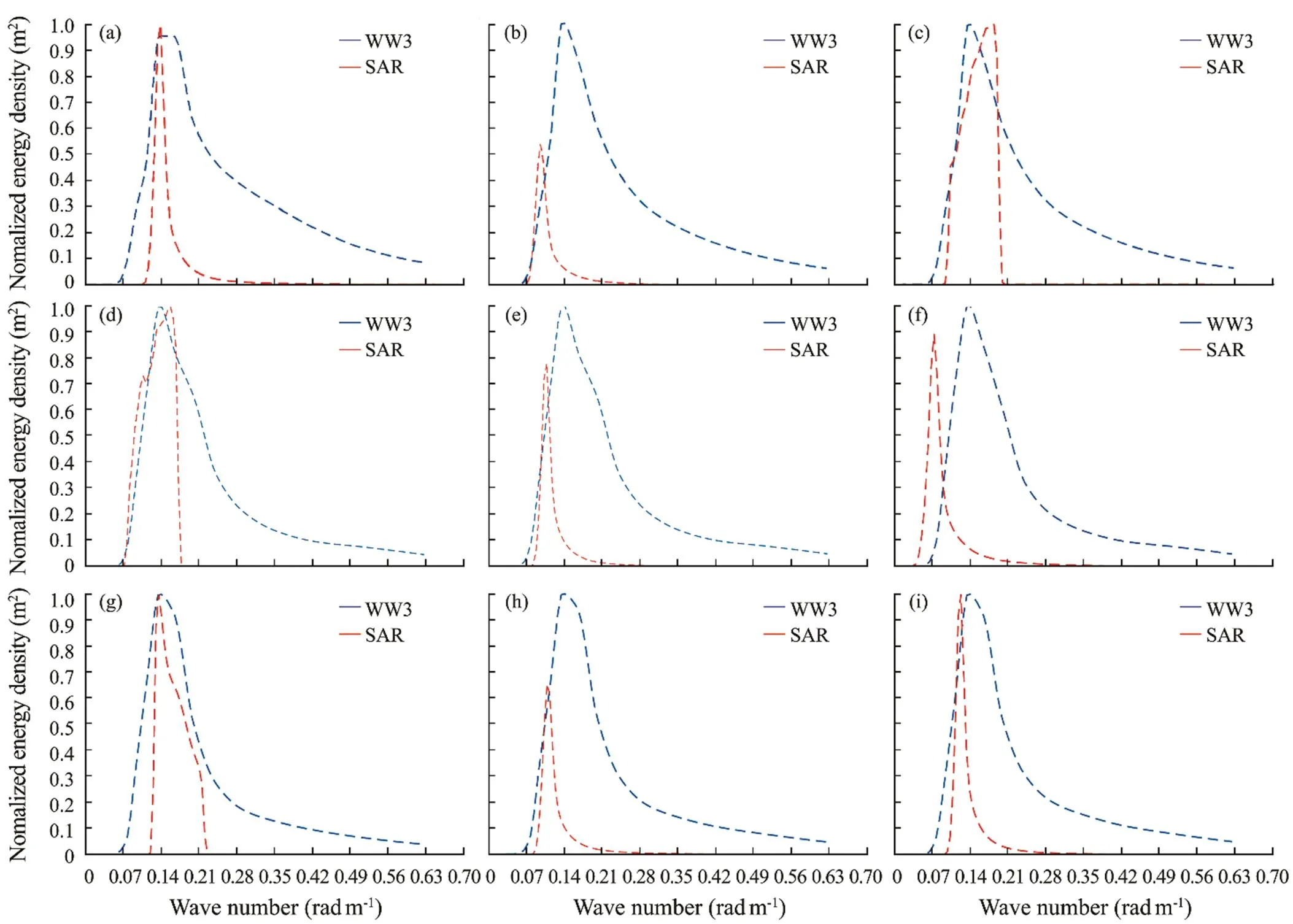
Fig.13 The one-dimensional wave spectra inverted from the sub-scenes at the locations in Fig.12, in which (a)-(i) cor- respond to A-I.
Acknowledgements
This research was partly supported by the National Nat- ural Science Foundation of China (Nos. 41906152 and 42076238). We greatly appreciate the National Center for Environmental Prediction of the National Oceanic and At- mospheric Administration for providing the source codefor the WAVEWATCH-III model free of charge. The Eu- ropean Centre for Medium-Range Weather Forecasts wind data were accessedhttp://www.ecmwf.int. The Gen- eral Bathymetry Chart of the Oceans (GEBCO) data were downloaded from ftp.edcftp.cr.usgs.gov. The operational Geophysical Data Record (OGDR) wave data following the footprints of the Jason-2 altimeter were downloaded from https://data.nodc.noaa.gov. The Advanced Scattero- meter 25km wind products provided by the Royal Neth- erlands Meteorological Institute were downloaded from http://archive.eumetsat.int. We would also like to thank the Aerospace Information Research Institute for providing the historical Advanced Land Observing Satellite images.
Alpers, W., and Brummer, B., 1994. Atmospheric boundary layer rolls observed by the synthetic aperture radar aboard the ERS-1satellite., 99 (C6): 2613-2621, DOI: 10.1029/94JC0042.
Alpers, W., Ross, D., and Rufenach, C., 1981. On the detectabil- ity of ocean surface waves by real and synthetic radar., 86(C7): 6481-6498, DOI: 10.1029/JC086iC07p06481.
Bi, L., Jung, J. A., Morgan, M. C., and Le Marshall, J. F., 2011. Assessment of assimilating ASCAT surface wind retrievals in the NCEP global data assimilation system., 139 (11): 3405-3421, DOI: 10.1175/2011MWR3391.1.
Ding, Y. Y., Zuo, J. C., Shao, W. Z., Shi, J., Yuan, X. Z., Sun, J.,, 2019. Wave parameters retrieval for dual-polarization C-band synthetic aperture radar using a theoretical-based al- gorithm under cyclonic conditions., 38 (5): 21-31, DOI: 10.1007/s13131-019-1438-y.
Ermakov, S. A., Sergievskaya, I. A., and Gushchin, L. A., 2012. Damping of gravity-capillary waves in the presence of oil slicks according to data from laboratory and numerical experiments., 48 (7): 565-572, DOI: 10.1134/S000143381204007X.
Esaias, W. E., Abbott, M. R., Barton, I., Brown, O. B., Campbell, J. W., Carder, K. L.,, 1998. An overview of MODIS ca- pabilities for ocean science observations., 36 (4): 1250-1265, DOI: 10.1109/36.701076.
Feindt, F., Schroter, J., and Alpers, W., 1986. Measurement of the ocean wave-radar modulation transfer function at 35GHz from a sea-based platform in the North Sea., 91 (C8): 9701-9708, DOI: 10.1029/JC091iC08p09701.
Grieco, G., Lin, W., Migliaccio, M., Nirchio, F., and Portabella, M., 2016. Dependency of the Sentinel-1 azimuth wavelength cut-off on significant wave height and wind speed., 37 (21): 5086-5104, DOI: 10.1080/01431161.2016.1226525.
Hasselmann, K., 1973. Measurements of wind-wave growth and swell decay during the Joint North Sea Wave Project (JONS- WAP)., 12 (2): 1-95, DOI: citeulike-article-id:2710264.
Hasselmann, K., and Hasselmann, S., 1991. On the nonlinear mapping of an ocean wave spectrum into a synthetic aperture radar image spectrum., 96 (C5): 10713-10729, DOI: 10.1029/91JC00302.
He, Y. J., Shen, H., and Perrie, W., 2006. Remote sensing of ocean waves by polarimetric SAR., 23 (12): 1768-1773, DOI: 10.1175/JTECH1948.1.
Hersbach, H., 2010. Comparison of C-band scatterometer CM- OD5.N equivalent neutral winds with ECMWF., 27 (4): 721-736, DOI: 10.1175/2009JTECHO698.1.
Hersbach, H., Stoffelen, A., and Haan, S., 2007. An improved C-band scatterometer ocean geophysical model function: CMOD5., 112 (C3): 225-237, DOI: 10.1029/2006JC003743.
Honkavaara, E., Saari, H., Kaivosoja, J., Pölönen, I., and Pesonen, L., 2013. Processing and assessment of spectrometric, stereo- scopic imagery collected using a lightweight UAV spectral cam- era for precision agriculture., 5 (10): 5006-5039, DOI: 10.3390/rs5105006.
Hu, Y. Y., Shao, W. Z., Shi, J., Sun, J., Ji, Q. Y., and Cai, I. N., 2020a. Analysis of the typhoon wave distribution simulated in WAVEWATCH-III model in the context of Kuroshio and wind-induced current., 38 (1): 1692-1710, DOI: 10.1007/s00343-019-9133-6.
Hu, Y. Y., Shao, W. Z., Wei, Y. L., and Zuo, J. C., 2020b. Analysis of typhoon-induced waves along typhoon tracks in the western North Pacific Ocean, 1998–2017., 8 (7): 521, DOI: 110.3390/jmse8070521.
Isoguchi, O., and Shimada, M., 2009. An L-band ocean geophys- ical model function derived from PALSAR., 47 (7): 1925-1936, DOI: 10.1109/TGRS.2008.2010864.
Jakobsson, M., and Macnab, R., 2006. A comparison between GEBCO sheet 5.17 and the international bathymetric chart of the Arctic Ocean (IBCAO) version 1.0., 27 (1): 35-48, DOI: 10.1007/s11001-005-7760-0.
Kudryavtsev, V., Hauser, D., Caudal, G., and Chapron, B., 2003. A semiempirical model of the normalized radar cross section of the sea surface, 2. Radar modulation transfer function., 108 (C3): FET31-FET316, DOI: 10.1029/2001JC001004.
Lehner, S., Horstmann, J., Koch, W., and Rosenthal, W., 1998. Mesoscale wind measurements using recalibrated ERS SAR images., 103: 7847-7856, DOI: 10.1029/97JC02726.
Li, X. M., and Lehner, S., 2014. Algorithm for sea surface wind retrieval from TerraSAR-X and TanDEM-X data., 52 (5): 2928-2939, DOI: 10.1109/TGRS.2013.2267780.
Li, X. M., Zhang, T. Y., Huang, B. Q., and Jia, T., 2018. Capa- bilities of Chinese Gaofen-3 synthetic aperture radar in selected topics for coastal and ocean observations., 10 (12): 1929, DOI: 110.3390/rs10121929.
Li, X., Lehner, S., and Bruns, T., 2011. Ocean wave integral pa- rameter measurements using Envisat ASAR wave mode data., 49 (1): 155-174, DOI: 10.1109/TGRS.2010.2052364.
Lyzenga, D., 1986. Numerical simulation of synthetic aperture radar image spectra for ocean waves., GE-24 (6): 863-872, DOI: 10.1109/TGRS.1986.289701.
Lyzenga, D., 2002. Unconstrained inversion of wave height spec- tra from SAR images., 40 (2): 261-270, DOI: 10.1109/36.992783.
Mastenbroek, C., and Valk, C., 2000. A semi-parametric algorithm to retrieve ocean wave spectra from synthetic aperture radar., 105 (C2): 3497-3516, DOI: 10.1029/1999JC900282.
Meng, T. Y., Yang, X. F., Chen, K. S., Nunziata, F., Xie, D. F., and Buono, A., 2022. Radar backscattering over sea surface oil emulsions: Simulation and observation., 60: 1-14, DOI: 10.1109/TGRS.2021.3073369.
Migliaccio, M., Huang, L., and Buono, A., 2019. SAR speckle dependence on ocean surface wind field., 57 (8): 5447-5455, DOI: 10.1109/TGRS.2019.2899491.
Monaldo, F., Jackson, C., Li, X. F., and Pichel, W., 2016. Pre- liminary evaluation of Sentinel-1A wind speed retrievals., 9 (6): 2638-2642, DOI: 10.1109/JSTARS.2015.2504324.
Mouche, A. A., Hauser, D., Daloze, J. F., and Guerin, C., 2005. Dual polarization measurements at C-band over the ocean: Re- sults from airborne radar observations and comparison with ENVISAT ASAR data., 43 (4): 753-769, DOI: 10.1109/TGRS.2005.843951.
Nunziata, F., De Macedo, C. R., Buono, A., Velotto, D., and Mig- liaccio, M., 2018. On the analysis of a time series of X-band Terrasar-X SAR imagery over oil seepages., 40 (9): 3623-3646, DOI: 10.1080/01431161.2018.1547933.
Pleskachevsky, A., Rosenthal, W., and Lehner, S., 2016. Meteo-Marine parameters for highly variable environment in coastal regions from satellite radar images., 119 (2): 464-484, DOI: 10.1016/j.isprsjprs.2016.02.001.
Price, J. M., Reed, M., Howard, M. K., Johnson, W. R., Ji, Z. G., Marshall, C. F.,, 2006. Preliminary assessment of an oil-spill trajectory model using satellite-tracked, oil-spill-simu- lating drifters., 21 (2): 258-270, DOI: 10.1016/j.envsoft.2004.04.025.
Quilfen, Y., Chapron, B., Elfouhaily, T., Katsaros, K., and Tour- nadre, J., 1998. Observation of tropical cyclones by high-res- olution scatterometry., 103 (C4): 7767-7786, DOI: 10.1029/97JC01911.
Schulz-Stellenfleth, J., Konig, T., and Lehner, S., 2007. An em- pirical approach for the retrieval of integral ocean wave pa- rameters from synthetic aperture radar data., 112 (C3): 10182-10190, DOI: 10.1029/2006JC003970.
Sergievskaya, I., Ermakov, S., Lazareva, T., and Guo, J., 2019. Damping of surface waves due to crude oil/oil emulsion films on water., 146 (9): 206-214, DOI: 10.1016/j.marpolbul.2019.06.018.
Shao, W. Z., Hu, Y. Y., Yang, J., Nunziata, F., Sun, J., and Li, H.,, 2018a. An empirical algorithm to retrieve significant wave height from Sentinel-1 synthetic aperture radar imagery collected under cyclonic conditions., 10 (9): 1367, DOI: 10.3390/rs10091367.
Shao, W. Z., Li, X. F., and Sun, J., 2015. Ocean wave parame- ters retrieval from TerraSAR-X images validated against buoy measurements and model results., 7 (10): 12815-12828, DOI: 10.3390/rs71012815.
Shao, W. Z., Li, X. M., Lehner, S., and Guan, C. L., 2014a. De- velopment of polarization ratio model for sea surface wind field retrieval from TerraSAR-X HH polarization data., 35 (11-12): 4046-4063, DOI: 10.1080/01431161.2014.916059.
Shao, W. Z., Nunziata, F., Zhang, Y. G., Corcione, V., and Migli- accio, M., 2021. Wind speed retrieval from the Gaofen-3 synthetic aperture radar for VV- and HH-polarization using a re-tuned algorithm., 54 (1): 318-337, DOI: 10.1080/22797254.2021.1924082.
Shao, W. Z., Sheng, Y. X., Li, H., Shi, J., Ji, Q. Y., Tan, W.,,2018b. Analysis of wave distribution simulated by WAVEWATCH-III model in typhoons passing Beibu Gulf, China., 9 (7): 265-284, DOI: 10.3390/atmos9070265.
Shao, W. Z., Sun, J., Guan, C. L., and Sun, Z. F., 2014b. A method for sea surface wind field retrieval from SAR image mode data., 13 (2): 198-204, DOI: 10.1007/s11802-014-1999-5.
Shao, W. Z., Yu, W. P., Jiang, X. W., Shi, J., Wei, Y. L., and Ji, Q. Y., 2022. Analysis of wave distribution using WAVEWATCH-III model in the Arctic Ocean., 21 (1): 15-27, DOI: 10.1007/s11802-022-4811-y.
Shao, W. Z., Zhu, S., Sun, J., Yuan, X. Z., Sheng, Y. X., Zhang, Q. J.,, 2018c. Evaluation of wind retrieval from co-po- larization Gaofen-3 SAR imagery around China Seas., 18 (1): 80-92, DOI: 10.1007/s11802-019-3779-8.
Sheng, Y. X., Shao, W. Z., Zhu, S., Sun, J., Yuan, X. Z., Li, S. Q.,, 2018. Validation of significant wave height retrieval from co-polarization Chinese Gaofen-3 SAR imagery by us- ing an improved algorithm., 37 (6): 302-315, DOI: 10.1007/s13131-018-1217-1.
Shimada, M., Lsoguchi, O., Tadono, T., and Isono, K., 2009. PALSAR radiometric and geometric calibration., 47 (12): 3915-3932, DOI: 10.1109/TGRS.2009.2023909.
Shimada, T., Kawamura, H., and Shimada, M., 2003. An L-band geophysical model function for SAR wind retrieval using JERS-1 SAR., 41 (3): 518-531, DOI: 10.1109/TGRS.2003.808836.
Shulz-Stellenfleth, J., Lehner, S., and Hoja, D., 2005. A para- metric scheme for the retrieval of two-dimensional ocean wave spectra from synthetic aperture radar look cross spectra., 110 (C5): C05004, DOI: 10.1029/2004JC002822.
Stoffelen, A., and Anderson, D., 1997. Scatterometer data inter- pretation estimation and validation of the CMOD4., 102 (102): 5767-5780, DOI:10.1029/96JC02860.
Stoffelen, A., Verspeek, J. A., Vogelzang, J., and Verhoef, A., 2017. The CMOD7 geophysical model function for ASCAT and ERS wind retrievals., 10 (5): 2123-2134, DOI: 10.1109/JSTARS.2017.2681806.
Stopa, J., and Mouche, A., 2017. Significant wave heights from Sentinel-1 SAR: Validation and applications., 122 (3): 1827-1848, DOI: 10.1002/2016JC012364.
Sun, J., and Kawamura, H., 2009. Retrieval of surface wave pa- rameters from SAR images and their validation in the coastal seas around Japan., 65 (4): 567-577, DOI: 10.1007/s10872-009-0048-2.
Sun, S., Lu, Y., Liu, Y., Wang, M., and Hu, C., 2018. Tracking an oil tanker collision and spilled oils in the East China Sea using multisensor day and night satellite imagery., 45 (7):3212-3220, DOI: 10.1002/2018GL077433.
The Wamdi Group, 1988. The WAM model–A third generation ocean wave prediction model., 18 (12): 1775-1810, DOI: 10.1175/1520-0485(1988)018<1775:TWMTGO>2.0.CO;2.
Tolman, H., and Chalikov, D., 1996. Source terms in a third-generation wind wave model., 26 (11): 2497-2518, DOI: 10.1175/1520-0485(1996)0262.0.CO;2.
Velotto, D., Migliaccio, M., Nunziata, F., and Lehner, S., 2011. Dual-polarized TerraSAR-X data for oil-spill observation., 49 (12): 4751-4762, DOI: 10.1109/TGRS.2011.2162960.
Verspeek, J., Stoffelen, A., Portabella, M., Bonekamp, H., An- derson, C., and Saldana, J. F., 2010. Validation and calibration of ASCAT using CMOD5.N., 48 (1): 386-395, DOI: 10.1109/TGRS.2009.2027896.
Voorrips, C., Mastenbroek, C., and Hansen, B., 2001. Validation of two algorithms to retrieve ocean wave spectra from ERS synthetic aperture radar., 106 (C8): 16825-16840, DOI: 10.1029/1999JC000156.
Yang, X. F., Li, X. F., Zheng, Q. A., Gu, X. F., Pichel, W. G., and Li, Z. W., 2011. Comparison of ocean surface winds retrieved from QuikSCAT scatterometer and Radarsat-1 SAR in offshore waters of the U.S. west coast., 8 (1): 163-167, DOI: 10.1109/LGRS.2010.2053345.
Yang, Z. H., Shao, W. Z., Hu, Y. Y., Ji, Q. Y., and Zhou, W., 2021.Revisit of a case study of spilled oil slicks caused by the Sanchi accident (2018) in the East China Sea., 9 (3): 279, DOI: 110.3390/jmse9030279.
Zhang, B., Perrie, W., and He, Y. J., 2010. Validation of RAD- ARSAT-2 fully polarimetric SAR measurements of ocean sur- face waves., 116 (C6): 302-315, DOI: 10.1029/2009JC005887.
Zheng, H., Zhang, Y., Wang, Y., Zhang, X., and Meng, J., 2017. The polarimetric features of oil spills in full polarimetric syn- thetic aperture radar images., 36 (5): 105-114, DOI: 10.1007/s13131-017-1065-4.
Zhu, S., Shao, W. Z., Armando, M., Shi, J., Sun, J., Yuan, X. Z.,, 2019. Evaluation of Chinese quad-polarization Gaofen-3 SAR wave mode data for significant wave height retrieval., 44 (6): 588-600, DOI: 10.1080/07038992.2019.1573136.
(August 24, 2021; revised October 27, 2021; accepted November 23, 2021)
© Ocean University of China, Science Press and Springer-Verlag GmbH Germany 2023
Corresponding authors. E-mail: wzshao@shou.edu.cn
E-mail: shenwei@wti.ac.cn
(Edited by Xie Jun)
杂志排行
Journal of Ocean University of China的其它文章
- The Subduction Structure Beneath the New Britain Island Arc and the Adjacent Region from Double-Difference Tomography
- Differences of Polygonal Faults with Irregularly Polygonal Geometries: A Case Study from the Changchang Sag of Qiongdongnan Basin, Northern South China Sea
- Characterization of Bacterial Communities in Aerosols over Northern Chinese Marginal Seas and the Northwestern Pacific Ocean in Autumn
- Assessment and Application of Beach Quality Based on Analytic Hierarchy Process in Yangkou Beach, Qingdao
- Role of Resuspended Sediments as Sources of Dissolved Inorganic Phosphorus Along Different Dimensions in the Subei Shoal, South Yellow Sea, China
- Pharmacokinetics of Enrofloxacin and Its Metabolite in Carp (Cyprinus carpio) After a Single Oral Administration in Medicated Feed
